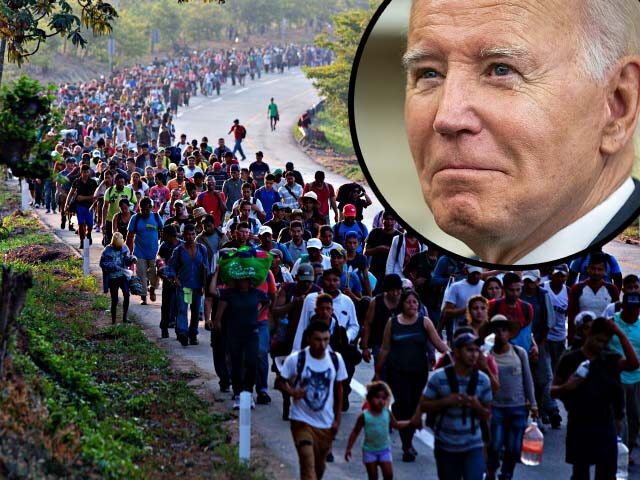President Joe Biden’s flood of migrants will force down Americans’ wages over the next 10 years, says a report by the Congress’ non-partisan team of economic experts.
The Congressional Budget Office “estimates that [Biden’s] increase in population will put downward pressure on average real wages [emphasis added],” said the report, which was released on February 7. “Average real wages are expected to be slightly lower by 2034 [emphasis added] than they would be otherwise,” the report said.
The official report reinforces the vast evidence that migration shifts family wages and workplace investment toward Wall Street, real estate, coastal states, and government, while also diverting politicians’ focus away from American communities.
The CBO report optimistically projects Biden’s migrant surge will be over by 2028. But it also predicts there will be no long-term recovery in Americans’ wages as investors and government use the migrant labor to absorb a greater share of new wealth produced each year:
From 2028 to 2034, labor income is projected to remain stable as a percentage of [Gross Domestic Product] GDP, averaging 57.1 percent. That projection is below labor income’s average percentage of GDP from 1947 to 2000, 60.4 percent [emphasis added], because some factors that have depressed labor income relative to GDP since 2000 are expected to persist in the coming decade.
The inflow of migrants will be a subsidy for the consumer economy and real estate companies, according to the report:
The increases to CBO’s population projections have raised projected consumer spending over the 2027–2033 period by roughly 2 percent, or 1.4 percent of GDP—and raised projected residential investment (such as spending on housing construction and home improvements) over that period by roughly 10 percent, or 0.4 percent of GDP—compared with the agency’s previous projections.
Many small-government libertarians praise migration, but the CBO noted that the inflow of poor migrants will also help grow government at a much faster rate:
In CBO’s projections, real government purchases grow at an average annual rate of 0.6 percent from 2025 to 2034. Federal purchases increase by an average of 0.4 percent a year during that period. Purchases by state and local governments increase much faster in that period, by an average of 0.7 percent a year, mainly because of federal assistance such as education grants.
Government debt will rise by $19 trillion, up to $54 trillion, by 2034, the report noted.
The arrival of millions of lower-wage laborers will be accompanied by a slowdown in productivity-boosting, wealth-generating business investment.
Four years after the coronavirus shock, that investment grew 4.1 percent in 2023, but CBO forecasts it to drop to just 2.7 percent per year during the 2029-34 period, the report notes. The reduced business investment will help slow the growth in wealth-generating productivity of U.S. workers.
Labor productivity grew 2.3 percent a year from 1950 to 1973 — so creating a vast middle class.

File/A young American family in the 1960s look over the gleaming choices on offer in a car showroom. (H. Armstrong Roberts/ClassicStock/Getty)
But productivity growth crashed down to 1.3 percent per year during the 2008-2023 period, partly because the federal government used a 1990 immigration-expansion law to create an economic bubble of cheap labor.
The 1990 law was signed by President George H. Bush, and the resulting labor bubble was further inflated by President George. W. Bush’s welcome for illegal migrants. Those migrants and their banks jointly helped to inflate the housing bubble that burst in 2007.
Biden’s migration and labor bubble will slow productivity gains to 1.2 percent from 2024 to 2028, the report noted.
The report explained how migration skews the economy:
Increased net immigration is projected to affect average real wages through several channels. First, additional foreign nationals are expected to work in sectors of the economy that pay relatively low wages, thus putting downward pressure on average wages. Second, the projected increase in workers reduces the amount of capital (factories and machinery) per worker, which also puts downward pressure on average real wages … By 2034, CBO estimates, the three effects combined will cause average real wages to be slightly lower than they would have been otherwise.
Still, the extra population of roughly 5.2 million working migrants by 2033 will expand the overall U.S. economy even as it also shrinks per-capita income, the report notes:
greater immigration is projected to boost the growth rate of the nation’s real gross domestic product (GDP) by an average of 0.2 percentage points a year from 2024 to 2034, leaving real GDP [Gross Domestic Product] roughly 2 percent larger in 2034 than it would be otherwise. Real GDP per person, however, would be 0.8 percent smaller in 2034 [emphasis addded] because of the increase in immigration than it would be otherwise, in CBO’s assessment.
A larger economy grows the nation’s pool of profits, which is good for people who own stocks and shares.
For example, a billion dollars in additional profits boosts the value of the stock market by roughly $20 billion. The multiplier effect gives companies an enormous incentive to hold down wages. For example, Wall Street stock analysts can use networked computers to easily track the wages of Americans — such as waitresses employed in Colorado diners — and to directly pressure company managers.
Yet Democrats touted the report for its Econ. 101 statement that migration expands the economy.
Migrants Line Up to Cross Into Texas via Biden Admin’s CBPOne App
Breitbart Texas“It is actually completely nonsensical that we do not talk about the enormous blessing, economic blessing that immigrants and immigration represent to the United States of America,” Rep. Alexandria Ocasio-Cortez (D-NY), told MSNBC on February 7.
The Wall Street Journal‘s columnists also rhapsodize about endless imported cheap labor. Holman W. Jenkins Jr., a member of the newspaper’s editorial board wrote on February 6:
My pitch for rational policy begins with a refundable border deposit. Able-bodied migrants without criminal records or suspect associations would be allowed in after putting down, say, $5,000. Profits would leach out of the people-smuggling racket. The money could be used to fund border enforcement and services for the new arrivals and credited against future income-tax liability, an incentive for upward mobility and complying with U.S. law.
In contrast, some GOP politicians are spotlighting the wealth transfer:
This border deal is a huge middle finger to working people. The cheap labor machine keeps on running
— Josh Hawley (@HawleyMO) February 5, 2024
Establishment media reports showcased by Google.com also focused on migrants’ growth of the economy.
“Immigration to Boost US GDP by $7 Trillion Over Decade, CBO Says,” declared the headline at Bloomberg.com.
Business Insider’s headline was “The US economy will grow by an extra $7 trillion over the next decade due to immigration, the CBO says.”
Advocates for more migration scoff at critics of migration by accusing them of claiming there is a limited number of jobs. But those advocates usually ignore the reality that wages, productivity, and investment are reduced by the government’s delivery of migrant labor.
For example, Paul Krugman is a pro-migration New York Times op-ed writer and economist. He wrote on February 6: “Even though immigrants as a group are responsible for all recent employment growth, they haven’t been taking jobs from the native-born, who are more likely to be employed in their prime working years than they were before the pandemic.”
Extraction Migration
Since at least 1990, the federal government has relied on Extraction Migration to grow the economy after it encouraged investors to move the high-wage manufacturing sector to lower-wage countries.
The migration policy extracts vast amounts of human resources from needy countries. The additional workers, consumers, and renters push up stock values by shrinking Americans’ wages, subsidizing low-productivity companies, boosting rents, and spiking real estate prices.
The economic policy has pushed many native-born Americans out of careers in a wide variety of business sectors, reduced native-born Americans’ productivity and political clout, reduced high-tech innovation, crippled civic solidarity, and allowed government officials and progressives to ignore the rising death rate of discarded Americans.
Texas DPS Catches Teens Smuggling Five Illegal Immigrants, Stuffed in Pick-Up Truck
Texas Department of Public SafetyThe policy also sucks jobs and wealth from heartland states by subsidizing coastal investors and government agencies with a flood of low-wage workers, high-occupancy renters, and government-aided consumers.
The colonialism-like policy has also killed many thousands of migrants, including many on the taxpayer-funded jungle trail through the Darien Gap in Panama.

COMMENTS
Please let us know if you're having issues with commenting.